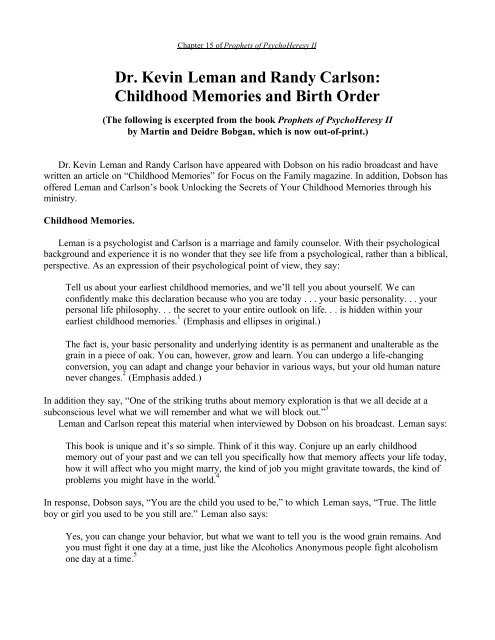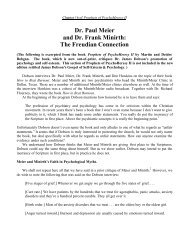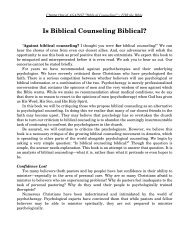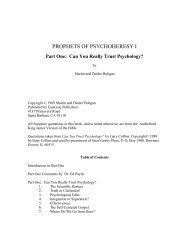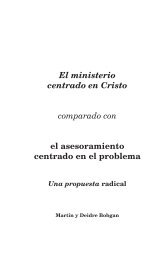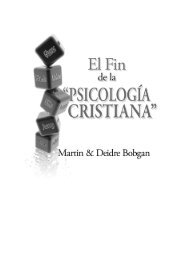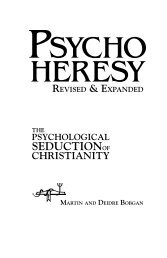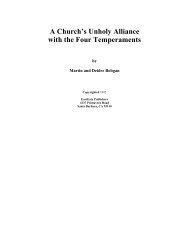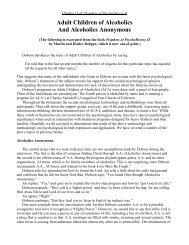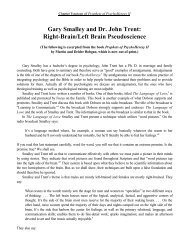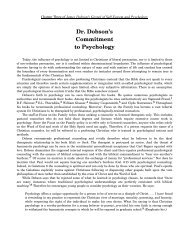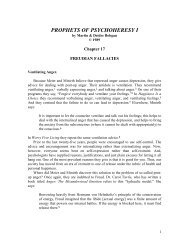Dr. Kevin Leman and Randy Carlson: Childhood Memories and ...
Dr. Kevin Leman and Randy Carlson: Childhood Memories and ...
Dr. Kevin Leman and Randy Carlson: Childhood Memories and ...
You also want an ePaper? Increase the reach of your titles
YUMPU automatically turns print PDFs into web optimized ePapers that Google loves.
Chapter 15 of Prophets of PsychoHeresy II<br />
<strong>Dr</strong>. <strong>Kevin</strong> <strong>Leman</strong> <strong>and</strong> R<strong>and</strong>y <strong>Carlson</strong>:<br />
<strong>Childhood</strong> <strong>Memories</strong> <strong>and</strong> Birth Order<br />
(The following is excerpted from the book Prophets of PsychoHeresy II<br />
by Martin <strong>and</strong> Deidre Bobgan, which is now out-of-print.)<br />
<strong>Dr</strong>. <strong>Kevin</strong> <strong>Leman</strong> <strong>and</strong> R<strong>and</strong>y <strong>Carlson</strong> have appeared with Dobson on his radio broadcast <strong>and</strong> have<br />
written an article on “<strong>Childhood</strong> <strong>Memories</strong>” for Focus on the Family magazine. In addition, Dobson has<br />
offered <strong>Leman</strong> <strong>and</strong> <strong>Carlson</strong>’s book Unlocking the Secrets of Your <strong>Childhood</strong> <strong>Memories</strong> through his<br />
ministry.<br />
<strong>Childhood</strong> <strong>Memories</strong>.<br />
<strong>Leman</strong> is a psychologist <strong>and</strong> <strong>Carlson</strong> is a marriage <strong>and</strong> family counselor. With their psychological<br />
background <strong>and</strong> experience it is no wonder that they see life from a psychological, rather than a biblical,<br />
perspective. As an expression of their psychological point of view, they say:<br />
Tell us about your earliest childhood memories, <strong>and</strong> we’ll tell you about yourself. We can<br />
confidently make this declaration because who you are today . . . your basic personality. . . your<br />
personal life philosophy. . . the secret to your entire outlook on life. . . is hidden within your<br />
earliest childhood memories. 1 (Emphasis <strong>and</strong> ellipses in original.)<br />
The fact is, your basic personality <strong>and</strong> underlying identity is as permanent <strong>and</strong> unalterable as the<br />
grain in a piece of oak. You can, however, grow <strong>and</strong> learn. You can undergo a life-changing<br />
conversion, you can adapt <strong>and</strong> change your behavior in various ways, but your old human nature<br />
never changes. 2 (Emphasis added.)<br />
In addition they say, “One of the striking truths about memory exploration is that we all decide at a<br />
subconscious level what we will remember <strong>and</strong> what we will block out.” 3<br />
<strong>Leman</strong> <strong>and</strong> <strong>Carlson</strong> repeat this material when interviewed by Dobson on his broadcast. <strong>Leman</strong> says:<br />
This book is unique <strong>and</strong> it’s so simple. Think of it this way. Conjure up an early childhood<br />
memory out of your past <strong>and</strong> we can tell you specifically how that memory affects your life today,<br />
how it will affect who you might marry, the kind of job you might gravitate towards, the kind of<br />
problems you might have in the world. 4<br />
In response, Dobson says, “You are the child you used to be,” to which <strong>Leman</strong> says, “True. The little<br />
boy or girl you used to be you still are.” <strong>Leman</strong> also says:<br />
Yes, you can change your behavior, but what we want to tell you is the wood grain remains. And<br />
you must fight it one day at a time, just like the Alcoholics Anonymous people fight alcoholism<br />
one day at a time. 5
The First Five or Six Years.<br />
In a different interview with Dobson, <strong>Leman</strong> says:<br />
The first five or six years in life----the one thing we as psychiatrists <strong>and</strong> psychologists agree on is--<br />
--those are the formative years. 6<br />
Dobson agrees by saying, “Yes,” <strong>and</strong> <strong>Leman</strong> continues:<br />
I say to parents, be aware that by the time your little three-year-old, you know, hits that tender age<br />
of three, 60 percent, perhaps, of their lifestyle, the way that they’re beginning to see life, has<br />
already been formed. 7<br />
A similar statement was also made by psychiatrist <strong>Dr</strong>. Paul Meier when he was interviewed by Dobson<br />
on the topic of “Christian Child Rearing.” In that interview Meier says, “Most of our children’s<br />
personality traits are laid down by the sixth birthday.” 8<br />
Such a viewpoint is not foreign to Dobson. He makes similar statements in his books. For instance,<br />
in Dare to Discipline, he says:<br />
There is a critical period during the first four or five years of a child’s life when he can be taught<br />
proper attitudes. These early concepts become rather permanent. When the opportunity of those<br />
years is missed, however, the prime receptivity usually vanishes, never to return. 9<br />
This particular point of view is basically Freudian. Freud would applaud <strong>Leman</strong>’s <strong>and</strong> <strong>Carlson</strong>’s<br />
statements <strong>and</strong> also Meier’s <strong>and</strong> Dobson’s.<br />
Freud believed in <strong>and</strong> taught about the power of early life experiences. Other theorists, such as<br />
Adler, exp<strong>and</strong>ed <strong>and</strong> modified those theories. The function of the subconscious is also Freudian. In fact,<br />
the above quotations are good expressions of Freudian psychology. It is unfortunate that <strong>Leman</strong>,<br />
<strong>Carlson</strong>, Meier, Dobson, <strong>and</strong> others rarely identify the psychological sources for what they say.<br />
However, if they did, what they say might be questioned.<br />
Freud’s theory of infantile sexuality lurks behind what <strong>Leman</strong> <strong>and</strong> <strong>Carlson</strong> say regarding early<br />
childhood memories <strong>and</strong> how “your personality <strong>and</strong> underlying identity is as permanent <strong>and</strong> unalterable<br />
as the grain in a piece of wood,” after those early years. According to Freud’s theory of infantile<br />
sexuality, the first five or six years of life pretty much determine the rest of a person’s life.<br />
Freud believed that every human being is confronted with four stages of development: oral, anal,<br />
phallic, <strong>and</strong> genital. He taught that the four stages of infantile sexuality follow one another <strong>and</strong> occur at<br />
certain ages in normal development. The oral stage is from birth to eighteen months; the anal stage is<br />
from eighteen months to three years; the phallic stage is from three to five or six years; <strong>and</strong> the genital<br />
stage continues through puberty. All four stages have to do with sexuality, <strong>and</strong> Freud related adult<br />
characteristics <strong>and</strong> mental-emotional disorders to childhood experiences within the various stages. He<br />
believed that if a person failed to pass successfully through each stage or experienced a trauma during<br />
one of the stages, there would be inexplicable damage to his psyche.<br />
Freud’s theory of infantile sexuality is also related to his theory of psychic determinism, both of<br />
which are within his theory of the unconscious. According to his theory of psychic determinism, each<br />
person is what he is because of the effect of the unconscious upon his entire life. Freud believed that “we<br />
are ‘lived’ by unknown <strong>and</strong> uncontrollable forces.” 10 He theorized that these forces are in the<br />
unconscious <strong>and</strong> control each person in the sense that they influence all that the person does. Thus, he<br />
saw people as puppets of the unknown <strong>and</strong> unseen unconscious, shaped by these forces during the first<br />
six years of life.
Freud contended that as each child passes from one psychosexual stage of development to another,<br />
his psyche is shaped by the people in his environment <strong>and</strong> especially by his parents. Psychic<br />
determinism establishes a process of blame that begins in the unconscious <strong>and</strong> ends with the parents.<br />
Freud removed a person’s responsibility for his behavior by teaching that everyone has been<br />
predetermined by his unconscious, which was shaped by the treatment given him by his parents during<br />
the first few years of his life.<br />
Research Refuting the First Five-Years Myth.<br />
In his book The Psychological Society, Martin Gross summarizes the work of <strong>Dr</strong>. Stella Chess,<br />
professor of child psychiatry at New York University Medical Center. Gross says that a potent<br />
conclusion that evolves from Chess’s work is that “the present psychiatric theory that the first six years<br />
of life are the exclusive molders of personality is patently false.” 11 (Emphasis his.)<br />
Social psychologist <strong>Dr</strong>. Carol Tavris discusses research about constancy versus change in an article<br />
titled “The Freedom to Change.” Referring to Freud <strong>and</strong> his psychoanalytic therapy, she says:<br />
Now the irony is that many people who are not fooled by astrology for one minute subject<br />
themselves to therapy for years, where the same errors of logic <strong>and</strong> interpretation often occur. . . .<br />
Astrologists think we are determined at birth (or even conception) by our stars; psychoanalysts<br />
think we are determined within a few years of birth by our parents (<strong>and</strong> our anatomy). 12<br />
Tavris cites research that opposes the idea of Freudian determinism <strong>and</strong> describes the work of <strong>Dr</strong>.<br />
Orville Brim of the Foundation for Child Development in New York. She says, “Most of Brim’s career<br />
has been devoted to charting the course of child development <strong>and</strong> its relation to adult personality.” She<br />
reports that Brim is convinced that “far from being programmed permanently by the age of 5, people are<br />
virtually reprogrammable throughout life.” She quotes him as saying, “Hundreds <strong>and</strong> hundreds of<br />
studies now document the fact of personality change in adulthood.” 13 In direct contradiction to the<br />
claims made by <strong>Leman</strong> et al, she also quotes Brim as saying:<br />
Social scientists are unable to predict adult personality from childhood or even from adolescence<br />
in any important way. We can’t blame the methods anymore, <strong>and</strong> we can’t say that people who<br />
don’t fit the predictions are deviant, unhealthy or strange. They are the norm. 14<br />
In addition to Brim, Tavris discusses the work of <strong>Dr</strong>. Jerome Kagan, a professor at Harvard<br />
University. Kagan, together with Howard Moss, wrote a classic book in the field titled Birth to Maturity:<br />
A Study in Psychological Development, which agrees with Meier <strong>and</strong> Minirth’s views. However, after<br />
further research, Kagan made a 180-degree turn in his ideas of child development. After taking a second<br />
look at Birth to Maturity, Kagan <strong>and</strong> Moss “could find little relation between psychological qualities<br />
during the first three years of life . . . <strong>and</strong> any aspect of behavior in adulthood.” 15 According to Tavris,<br />
“Kagan now believes that few of a baby’s attributes last indefinitely, unless the environment perpetuates<br />
them.” 16<br />
Brim <strong>and</strong> Kagan later wrote a book together titled Constancy <strong>and</strong> Change in Human Development.<br />
They say:<br />
The view that emerges from this work is that humans have a capacity for change across the entire<br />
life span. . . there are important growth changes across the life span from birth to death, many<br />
individuals retain a great capacity for change, <strong>and</strong> the consequences of the events of early<br />
childhood are continually transformed by later experiences, making the course of human<br />
development more open than many have believed. 17
In letters to us, Brim <strong>and</strong> Kagan declare that what evidence there is, <strong>and</strong> there is a good amount of it,<br />
shows a continuing change in personality over the lifespan. 18<br />
We also wrote to <strong>Dr</strong>. Bernard Riml<strong>and</strong>, who is the director of the Institute for Child Behavior<br />
Research in San Diego. In his reply he says that the idea “that the personality is the product of the<br />
individual psychosocial experiences . . . is totally unsupportable by any scientific evidence that I’ve been<br />
able to find.” 19<br />
Pseudoscience of Memory Recording.<br />
<strong>Leman</strong> <strong>and</strong> <strong>Carlson</strong> indulge in some psychological pseudoscience when they say, “The view of life<br />
you picked up back when you were just a little tyke is non-erasable.” And then they say:<br />
Every experience we’ve had since birth has been recorded <strong>and</strong> tucked away safely in our brains.<br />
Like the most sophisticated computer in the world, the brain retrieves the memories we need when<br />
we need them. 20<br />
In a different interview with Dobson, <strong>Dr</strong>. Donald Joy uses a different metaphor for the brain. He says:<br />
The woman’s brain works like a computer. . . . the left hemisphere in the male is more like what I<br />
call an old fashioned adding machine. 21<br />
However, <strong>Dr</strong>. John Searle, in his Reith Lecture “Minds, Brains, <strong>and</strong> Science,” talks about the<br />
shortcomings of using the computer metaphor for the brain. He says:<br />
Because we don’t underst<strong>and</strong> the brain very well we’re constantly tempted to use the latest<br />
technology as a model for trying to underst<strong>and</strong> it.<br />
In my childhood we were always assured that the brain was a telephone switchboard. (“What else<br />
could it be?”) And I was amused to see that Sherrington, the great British neuroscientist, thought<br />
that the brain worked like a telegraph system. Freud often compared the brain to hydraulic <strong>and</strong><br />
electro-magnetic systems. Leibniz compared it to a mill, <strong>and</strong> now, obviously, the metaphor is the<br />
digital computer. . . .<br />
The computer is probably no better <strong>and</strong> no worse as a metaphor for the brain than earlier<br />
mechanical metaphors. We learn as much about the brain by saying it’s a computer as we do by<br />
saying it’s a telephone switchboard, a telegraph system, a water pump, or a steam engine. 22<br />
What Searle is getting at is the fact that the brain is not a mechanical piece of technology.<br />
In his book Remembering <strong>and</strong> Forgetting: Inquiries into the Nature of Memory, Edmund Bolles<br />
says, “The human brain is the most complicated structure in the known universe.” 23 In introducing his<br />
book he says:<br />
For several thous<strong>and</strong> years people have believed that remembering retrieves information stored<br />
somewhere in the mind. The metaphors of memory have always been metaphors of storage: We<br />
preserve images on wax; we carve them in stone; we write memories as with a pencil on paper; we<br />
file memories away; we have photographic memories; we retain facts so firmly they seem held in a<br />
steel trap. Each of these images proposes a memory warehouse where the past lies preserved like<br />
childhood souvenirs in an attic. This book reports a revolution that has overturned that vision of<br />
memory. Remembering is a creative, constructive process. There is no storehouse of information<br />
about the past anywhere in our brain. 24 (Emphasis added.)
After discussing the scientific basis for memory <strong>and</strong> how the brain functions, he says, “The biggest loser<br />
in this notion of how memory works is the idea that computer memories <strong>and</strong> human memories have<br />
anything in common.” He goes on to say, “Human <strong>and</strong> computer memories are as distinct as life <strong>and</strong><br />
lightning.” 25<br />
Medical doctor <strong>and</strong> researcher Nancy Andreasen says in her book The Broken Brain that “there is no<br />
accurate model or metaphor to describe how [the brain] works.” She concludes that “the human brain is<br />
probably too complex to lend itself to any single metaphor.” 26<br />
Interpretation of <strong>Memories</strong>?<br />
<strong>Leman</strong> <strong>and</strong> <strong>Carlson</strong> do some memory interpretation on Dobson’s program. As an example, Dobson<br />
tells about an early life memory. <strong>Leman</strong> <strong>and</strong> <strong>Carlson</strong> go on to tell that early life memories (“crib<br />
memories”) <strong>and</strong> sensory memories (such as “smells, textures, <strong>and</strong> colors”) indicate creativity. They<br />
conclude from Dobson’s example that “he is, in fact, creative.” Unfortunately for <strong>Leman</strong> <strong>and</strong> <strong>Carlson</strong>,<br />
early memory interpretation has about as much validity as dream interpretation.<br />
<strong>Dr</strong>. Jeffrey Masson says:<br />
Interpreting another person’s dream is at best a subjective <strong>and</strong> hazardous undertaking. . . . Any<br />
therapist’s claim to “underst<strong>and</strong>” another person’s dream is foolhardy. 27<br />
We would say that <strong>Leman</strong> <strong>and</strong> <strong>Carlson</strong>’s early life memory interpretation is “at best a subjective <strong>and</strong><br />
hazardous undertaking” <strong>and</strong> any claim to “underst<strong>and</strong>” another person’s early life memory is foolhardy.<br />
They present no valid support for such a claim either in their book or in the Dobson interview.<br />
Prediction from <strong>Memories</strong>.<br />
Even more outrageous is the following interchange between Dobson <strong>and</strong> <strong>Leman</strong>. Dobson asks, “Can<br />
you predict from a memory?” <strong>Leman</strong> answers emphatically, “Absolutely! You really can.” <strong>Leman</strong> then<br />
gives an example of how this works with procrastinators. He says:<br />
They don’t realize it, but the secret of why they behave that way is locked in their early childhood<br />
memory. And you asked before, can these things be predictive? They sure can be. Because the<br />
woman who has a critical father is going to end up with a behavior that’s going to be very<br />
consistent with procrastination. 28<br />
Not even Sigmund Freud would risk predicting behavior. However, <strong>Leman</strong> <strong>and</strong> <strong>Carlson</strong> are certain<br />
enough to say, “Absolutely!” in response to Dobson’s question about predicting from a memory. If<br />
<strong>Leman</strong> <strong>and</strong> <strong>Carlson</strong> have research to support their early life memory interpretation <strong>and</strong> predictions, they<br />
should provide it. In instances of such stupendous promises without visible support, it is better to assume<br />
that the information is false.<br />
Remembering <strong>and</strong> Forgetting.<br />
Another problem with the interview is that Dobson quotes some studies on the brain, which were<br />
conducted by two neurosurgeons. He says:<br />
It was obvious that with this electrical stimulation you could access everything that was there. It’s<br />
all there. . . . It’s locked in. . . . Everything you have experienced is there in the brain. 29 (Emphasis<br />
added.)
Based upon current scientific information it is doubtful that any neuroscientist would say, “Everything<br />
you have experienced is there in the brain.” Dobson no doubt believes this, but he should not be so<br />
categorical without supporting evidence.<br />
The Oxford Companion to the Mind discusses the problems associated with forgetting. You will not<br />
find anything like the above Dobson statement in that book. The book does raise such questions as: How<br />
would one know whether the memories are still there or gone? What is the evidence of what is known as<br />
memory “storage loss”? 30 One would have to know more about the brain than is currently known in<br />
order to determine whether or not Dobson’s statement is true. Yet, Dobson says it with Dobsonesque<br />
confidence.<br />
We looked at a number of other books regarding memory storage loss, including Remembering <strong>and</strong><br />
Forgetting 31 <strong>and</strong> The Broken Brain. 32 No book we examined had such a statement. Dobson’s<br />
categorically confident statements are eagerly accepted by a public that would often rather be told<br />
something with certainty than to have to use their gray matter to deal with issues that are not black <strong>and</strong><br />
white.<br />
<strong>Leman</strong> <strong>and</strong> <strong>Carlson</strong>’s formula is a combination of the power of early life memories in present life,<br />
the relative permanence <strong>and</strong> unalterability of a person’s basic personality, <strong>and</strong> the brain functioning like<br />
a computer to retrieve subconscious memories that are non-erasable. This is a fictitious formula, a false<br />
facade, <strong>and</strong> a flimsy foundation. Yet Dobson, as he often does, publicizes <strong>and</strong> promotes their work<br />
without first proving it.<br />
The Birth Order Myth.<br />
<strong>Leman</strong> also has a book titled The Birth Order Book: Why You Are the Way You Are. He says,<br />
“Whatever your family was, you are.” 33 Dobson has said, “The Birth Order Book has sold over a halfmillion<br />
copies.” In response to the declining birth rate, <strong>Leman</strong> says, “A greater proportion of first-borns<br />
<strong>and</strong> only children will make us a society of flaw-pickers, yuppies, <strong>and</strong> achievers.” In answer to the<br />
question asked by Christianity Today, “Can most church pastors who do a fair amount of counseling use<br />
birth-order after reading a book or two?” <strong>Leman</strong> answers:<br />
Absolutely. I have tried to train pastors in a seminar called “Counseling Families When You Don’t<br />
Have Much Time.” This is an economical way to get behind the eyes of someone in the church <strong>and</strong><br />
underst<strong>and</strong> their family <strong>and</strong> their plight in life. 34<br />
Dobson interviews <strong>Leman</strong> on another program <strong>and</strong> refers to The Birth Order Book as “very relevant<br />
to parenting.” He says to <strong>Leman</strong>, “I agree with your Birth Order Book,” but to his credit Dobson<br />
disagrees with the subtitle, “Why You Are the Way You Are.” However, after some discussion, the two<br />
agree that the subtitle is not meant to be an absolute. At the end of the broadcast Dobson says, “I think<br />
you have a real winner here. . . . Keep writing.” 35<br />
Concerning birth order, <strong>Leman</strong> tells Dobson:<br />
The difference that is evident in kids lives between the first-born child, the second-born child in<br />
the family, you can almost guarantee they’re going to be the opposite. As we go down the family<br />
branch we see that each child branches off in a very unique way. 36<br />
Dobson brings up the question of research by saying, “You really base the book on research. It’s not just<br />
impressions you have.” <strong>Leman</strong> replies, “There’s hard research to substantiate there is something to birth<br />
order.” He then says:<br />
We find that people in certain occupational areas <strong>and</strong> expertise in life, such as architecture,<br />
accounting, engineering, those structured occupations tend to be first-born children. As we go
through the family constellation <strong>and</strong> go through second children, youngest children, we find that<br />
people go into much more people-oriented vocations. 37<br />
<strong>Leman</strong> also says, “The biblical characters in the Bible prove out birth order very well.” 38<br />
It is obvious that <strong>Leman</strong> is enthusiastic about the relationship between birth order <strong>and</strong> personality.<br />
However, contrary to what he says, the research has not proven it. Science magazine featured a special<br />
report by John Tierney on “The Myth of the Firstborn.” Tierney says, “Birth order theory makes an<br />
appealing neat way to categorize human beings-----like astrology, but with scientific trappings.” He<br />
declares:<br />
After reviewing 35 years of research-----some 1,500 studies-----Cécile Ernst <strong>and</strong> Jules Angst of the<br />
University of Zurich reach a simple conclusion: On a scale of importance, the effects of birth order<br />
fall somewhere between negligible <strong>and</strong> nonexistent. 39 (Emphasis added.)<br />
One wonders about the “hard research” to which <strong>Leman</strong> might be referring.<br />
Promises, Promises, Promises.<br />
In addition to the subtitle of <strong>Leman</strong>’s book, the following is found on the cover of the book:<br />
FIRST BORN? MIDDLE CHILD? BABY OF THE FAMILY?<br />
FIND OUT WHAT IT MEANS FOR YOUR CAREER, YOUR KIDS, AND YOUR<br />
MARRIAGE. . . . 40<br />
Also, on the cover of the book are the following:<br />
THE COMBINATION THAT MAKES THE PERFECT MARRIAGE MATCH<br />
THE CAREER CHOICE THAT FITS YOU BEST<br />
HOW TO MAKE YOUR BIRTH ORDER WORK FOR YOU<br />
AND MUCH, MUCH MORE. . . . 41<br />
These are outrageous direct <strong>and</strong> implied promises that are based upon opinion, not fact. <strong>Leman</strong> says in<br />
the book, “Birth order has nothing to do with astrology, but it definitely affects your personality, whom<br />
you marry, your children, your occupational choice, <strong>and</strong> even how well you get along with God.” 42<br />
While birth order has nothing directly to do with astrology, there is a similarity. Both astrology <strong>and</strong><br />
birth order lack scientific support for their validity. Also, Unlocking the Secrets of Your <strong>Childhood</strong><br />
<strong>Memories</strong> lacks proper scientific support, <strong>and</strong> like astrology both of these books are based upon opinion<br />
unsubstantiated by research.<br />
Where is God in all of this? As usual, almost totally absent. Read Unlocking the Secrets of Your<br />
<strong>Childhood</strong> <strong>Memories</strong> <strong>and</strong> The Birth Order Book. See if you can find God there beyond a few passing<br />
references. Nor is He given any preeminence on the Focus on the Family programs which are devoted to<br />
psychological notions.<br />
In both Unlocking the Secrets of Your <strong>Childhood</strong> <strong>Memories</strong> <strong>and</strong> The Birth Order Book the premises<br />
upon which they rest are false. A false foundation can only result in false theories, techniques <strong>and</strong><br />
methodologies, which is the case with these two books. Even people who love psychology should look<br />
askance at such books. Once more no caveat emptor (buyer beware) from Dobson. He interviews<br />
<strong>Leman</strong>, promotes the popularized pseudoscience <strong>and</strong> then goes on to the next psychologist <strong>and</strong><br />
psychologizer.
Notes<br />
1. <strong>Kevin</strong> <strong>Leman</strong> <strong>and</strong> R<strong>and</strong>y <strong>Carlson</strong>, “<strong>Childhood</strong> <strong>Memories</strong>: The way we were (<strong>and</strong> still are today).” Focus on<br />
the Family, August 1989, p. 6.<br />
2. Ibid., pp. 6-7.<br />
3. Ibid., p. 7.<br />
4. <strong>Kevin</strong> <strong>Leman</strong> interview, “<strong>Childhood</strong> <strong>Memories</strong>: Underst<strong>and</strong>ing Yourself,” Focus on the Family Radio<br />
Broadcast, CS 481, side 1<br />
5. Ibid., side 2.<br />
6. <strong>Kevin</strong> <strong>Leman</strong> interview, “Birth Order,” Focus on the Family Radio Broadcast, CS 181, side 1.<br />
7. Ibid.<br />
8. Paul Meier interview, “Christian Child Rearing,” Focus on the Family Radio Broadcast, CS 145.<br />
9. James Dobson. Dare to Discipline. Wheaton, IL: Tyndale House Publishers, Inc., 1970, p. 9.<br />
10. Sigmund Freud. The Ego <strong>and</strong> the Id. Translated by Joan Riviere; revised <strong>and</strong> edited by James Strachey.<br />
New York: W. W. Norton <strong>and</strong> Company, Inc., 1960, p. 13.<br />
11. Martin Gross. The Psychological Society. New York: R<strong>and</strong>om House, 1978, p. 254.<br />
12. Carol Tavris, “The Freedom to Change,” Prime Time, October 1980, p. 28.<br />
13. Ibid., p. 31.<br />
14. Ibid.<br />
15. Ibid., p. 32.<br />
16. Ibid.<br />
17. Orville G. Brim, Jr. <strong>and</strong> Jerome Kagan. Constancy <strong>and</strong> Change in Human Development. Cambridge:<br />
Harvard University Press, p. 1980, p. 1.<br />
18. Letter on file.<br />
19. Letter on file.<br />
20. <strong>Leman</strong> <strong>and</strong> <strong>Carlson</strong>, “<strong>Childhood</strong> <strong>Memories</strong>,” op. cit., p. 7.<br />
21. Donald Joy interview, “The Innate Differences between Males <strong>and</strong> Females,” Focus on the Family Radio<br />
Broadcast, CS-099, 1984, 1986.<br />
22. John Searle. Minds, Brains <strong>and</strong> Science. The 1984 Reith Lectures. London: British Broadcasting<br />
Corporation, 1984, pp. 44, 55-56.<br />
23. Edmund Bolles. Remembering <strong>and</strong> Forgetting. New York: Walker <strong>and</strong> Company, 1988, p. 139.<br />
24. Ibid., p. xi.<br />
25. Ibid., p. 165.<br />
26. Nancy C. Andreasen. The Broken Brain. New York: Harper & Row, Publishers, 1984, p. 90.<br />
27. Jeffrey Moussaieff Masson. Against Therapy: Emotional Tyranny <strong>and</strong> the Myth of Psychological Healing.<br />
New York: Atheneum, 1988, p. 119.<br />
28. <strong>Leman</strong>, “<strong>Childhood</strong> <strong>Memories</strong>,” interview, op. cit., side 1.<br />
29. Ibid., side 2.<br />
30.<br />
pp. 261, 264-265.<br />
Richard L. Gregory, ed. The Oxford Companion to the Mind. New York: Oxford University Press, 1987,<br />
31. Bolles, op. cit.<br />
32. Andreasen, op. cit.<br />
33. <strong>Kevin</strong> <strong>Leman</strong>, “Christianity Today Talks to <strong>Kevin</strong> <strong>Leman</strong>.” Christianity Today, 18 October 1985, p. 49.<br />
34. Ibid.<br />
35. Dobson <strong>and</strong> <strong>Leman</strong>, “Birth Order, op. cit.<br />
36. Ibid.<br />
37. Ibid.<br />
38. Ibid.<br />
39. John Tierney, “The Myth of the Firstborn,” Science, December 1983, p. 16.<br />
40. <strong>Kevin</strong> <strong>Leman</strong>. The Birth Order Book: Why You Are the Way You Are. Old Tappan, NJ: Spire Books,<br />
Fleming H. Revell Company, 1985, front cover.<br />
41. Ibid.<br />
42. Ibid., p. 13.<br />
BOOK CHAPTERS<br />
Copyright © 1990 Martin <strong>and</strong> Deidre Bobgan<br />
Published by EastGate Publishers<br />
Santa Barbara, California


